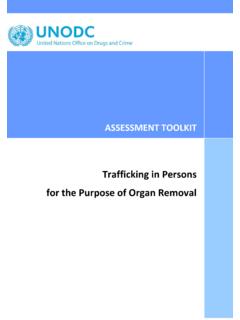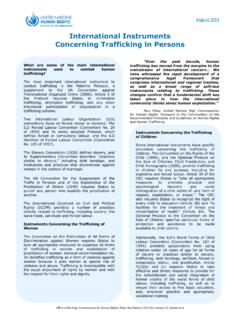Transcription of METHODOLOGY - FATF-GAFI.ORG
1 METHODOLOGY FOR ASSESSING TECHNICAL. COMPLIANCE WITH THE FATF. RECOMMENDATIONS AND THE. EFFECTIVENESS OF AML/CFT SYSTEMS. Updated February 2018. FINANCIAL ACTION TASK FORCE. The Financial Action Task Force (FATF) is an independent inter-governmental body that develops and promotes policies to protect the global financial system against money laundering, terrorist financing and the financing of proliferation of weapons of mass destruction. The FATF Recommendations are recognised as the global anti-money laundering (AML) and counter-terrorist financing (CFT) standard. For more information about the FATF, please visit the website: This document and/or any map included herein are without prejudice to the status of or sovereignty over any territory, to the delimitation of international frontiers and bounderies and to the name of any territory, city or area. Citing reference: FATF (2013-2018), METHODOLOGY for Assessing Compliance with the FATF Recommendations and the Effectiveness of AML/CFT Systems, updated February 2018, FATF, Paris, France, 2013-2018 FATF/OECD.
2 All rights reserved. No reproduction or translation of this publication may be made without prior written permission. Applications for such permission, for all or part of this publication, should be made to the FATF Secretariat, 2 rue Andr Pascal 75775 Paris Cedex 16, France (fax: +33 1 44 30 61 37 or e-mail: METHODOLOGY . FOR ASSESSING TECHNICAL COMPLIANCE WITH THE FATF. RECOMMENDATIONS. AND THE EFFECTIVENESS OF AML/CFT SYSTEMS. ADOPTED IN FEBRUARY 2013. Updated February 2018. METHODOLOGY . ASSESSING TECHNICAL COMPLIANCE WITH THE FATF RECOMMENDATIONS AND THE EFFECTIVENESS OF AML/CFT SYSTEMS. 2 TABLE OF ACRONYMS. METHODOLOGY . ASSESSING TECHNICAL COMPLIANCE WITH THE FATF RECOMMENDATIONS AND THE EFFECTIVENESS OF AML/CFT SYSTEMS. CONTENTS. CONTENTS ..3. INTRODUCTION ..5. TECHNICAL COMPLIANCE ..12. EFFECTIVENESS ..15. TECHNICAL COMPLIANCE ASSESSMENT ..23. EFFECTIVENESS ASSESSMENT ..93. ANNEX I SUPRA-NATIONAL ASSESSMENT.)
3 123. ANNEX II MUTUAL EVALUATION REPORT TEMPLATE ..124. FATF GUIDANCE LEGAL BASIS OF REQUIREMENTS ON FINANCIAL INSTITUTIONS AND GLOSSARY ..149. INFORMATION ON UPDATES MADE TO THE FATF METHODOLOGY ..165. TABLE OF ACRONYMS 3. METHODOLOGY . ASSESSING TECHNICAL COMPLIANCE WITH THE FATF RECOMMENDATIONS AND THE EFFECTIVENESS OF AML/CFT SYSTEMS. TABLE OF ACRONYMS. AML/CFT Anti-Money Laundering / Countering the Financing of Terrorism (also used for Combating the financing of terrorism). BNI Bearer-Negotiable Instrument CDD Customer Due Diligence CFT Countering the financing of terrorism DNFBP Designated Non-Financial Business or Profession FATF Financial Action Task Force FIU Financial Intelligence Unit IO Immediate Outcome IN Interpretive Note ML Money Laundering MOU Memorandum of Understanding MVTS Money or Value Transfer Service(s). NPO Non-Profit Organisation Palermo convention The United Nations convention against transnational organized crime 2000.
4 PEP Politically Exposed Person R. Recommendation RBA Risk-Based Approach SRB Self-Regulating Bodies STR Suspicious Transaction Report TCSP Trust and Company Service Provider Terrorist Financing The International convention for the Suppression of the Financing convention of Terrorism 1999. TF Terrorist Financing UN United Nations UNSCR United Nations Security Council Resolutions Vienna convention The United Nations convention against Illicit Traffic in Narcotic Drugs and Psychotropic Substances 1988. 4. METHODOLOGY . ASSESSING TECHNICAL COMPLIANCE WITH THE FATF RECOMMENDATIONS AND THE EFFECTIVENESS OF AML/CFT SYSTEMS. INTRODUCTION. 1. This document provides the basis for undertaking assessments of technical compliance with the revised FATF Recommendations, adopted in February 2012, and for reviewing the level of effectiveness of a country's Anti-Money Laundering / Countering the Financing of Terrorism (AML/CFT) system.
5 It consists of three sections. This first section is an introduction, giving an overview of the assessment METHODOLOGY 1, its background, and how it will be used in evaluations/assessments. The second section sets out the criteria for assessing technical compliance with each of the FATF Recommendations. The third section sets out the outcomes, indicators, data and other factors used to assess the effectiveness of the implementation of the FATF. Recommendations. The processes and procedures for Mutual Evaluations are set out in a separate document. 2. For its 4th round of mutual evaluations, the FATF has adopted complementary approaches for assessing technical compliance with the FATF Recommendations, and for assessing whether and how the AML/CFT system is effective. Therefore, the METHODOLOGY comprises two components: The technical compliance assessment addresses the specific requirements of the FATF Recommendations, principally as they relate to the relevant legal and institutional framework of the country, and the powers and procedures of the competent authorities.
6 These represent the fundamental building blocks of an AML/CFT system. The effectiveness assessment differs fundamentally from the assessment of technical compliance. It seeks to assess the adequacy of the implementation of the FATF Recommendations, and identifies the extent to which a country achieves a defined set of outcomes that are central to a robust AML/CFT. system. The focus of the effectiveness assessment is therefore on the extent to which the legal and institutional framework is producing the expected results. 3. Together, the assessments of both technical compliance and effectiveness will present an integrated analysis of the extent to which the country is compliant with the FATF Standards and how successful it is in maintaining a strong AML/CFT system, as required by the FATF Recommendations. 4. This METHODOLOGY is designed to assist assessors when they are conducting an assessment of a country's compliance with the international AML/CFT standards.
7 It reflects the requirements set out in the FATF Recommendations and Interpretive Notes, which constitute the international standard to combat money laundering and the financing of terrorism and proliferation, but does not amend or override them. It will assist assessors in identifying the systems and mechanisms developed by 1 The terms assessment , evaluation and their derivatives are used throughout this document, and refer to both mutual evaluations undertaken by the FATF and FSRBs and third-party assessments ( assessments undertaken by the IMF and World Bank). INTRODUCTION 5. METHODOLOGY . ASSESSING TECHNICAL COMPLIANCE WITH THE FATF RECOMMENDATIONS AND THE EFFECTIVENESS OF AML/CFT SYSTEMS. countries with diverse legal, regulatory and financial frameworks in order to implement effective AML/CFT systems; and is also useful for countries that are reviewing their own systems, including in relation to technical assistance needs.
8 This METHODOLOGY is also informed by the experience of the FATF, the FATF-style regional bodies (FSRBs), the International Monetary Fund and the World Bank in conducting assessments of compliance with earlier versions of the FATF Recommendations. RISK AND CONTEXT. 5. The starting point for every assessment is the assessors' initial understanding of the country's risks and context, in the widest sense, and elements which contribute to them. This includes: the nature and extent of the money laundering and terrorist financing risks ;. the circumstances of the country, which affect the materiality of different Recommendations ( , the makeup of its economy and its financial sector);. structural elements which underpin the AML/CFT system; and other contextual factors which could influence the way AML/CFT measures are implemented and how effective they are. 6. The ML/TF risks are critically relevant to evaluating technical compliance with Recommendation 1 and the risk-based elements of other Recommendations, and to assess effectiveness.
9 Assessors should consider the nature and extent of the money laundering and terrorist financing risk factors to the country at the outset of the assessment, and throughout the assessment process. Relevant factors can include the level and type of proceeds-generating crime in the country;. the terrorist groups active or raising funds in the country; exposure to cross-border flows of criminal or illicit assets. 7. Assessors should use the country's own assessment(s) of its risks as an initial basis for understanding the risks, but should not uncritically accept a country's risk assessment as correct, and need not follow all its conclusions. Assessors should also note the guidance in paragraph 15, below on how to evaluate risk assessments in the context of Recommendation 1 and Immediate Outcome 1. There may be cases where assessors cannot conclude that the country's assessment is reasonable, or where the country's assessment is insufficient or non-existent.
10 In such situations, they should consult closely with the national authorities to try to reach a common understanding of what are the key risks within the jurisdiction. If there is no agreement, or if they cannot conclude that the country's assessment is reasonable, then assessors should clearly explain any differences of understanding, and their reasoning on these, in the Mutual Evaluation Report (MER); and should use their understanding of the risks as a basis for assessing the other risk-based elements ( risk- based supervision). 8. Assessors should also consider issues of materiality, including, for example, the relative importance of different parts of the financial sector and different DNFBPs; the size, integration and make-up of the financial sector; the relative importance of different types of financial products or institutions; the amount of business which is domestic or cross-border; the extent to which the economy is cash-based; and estimates of the size of the informal sector and/or shadow economy.















